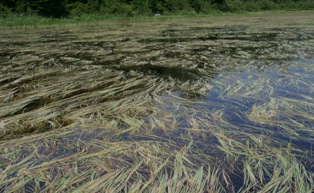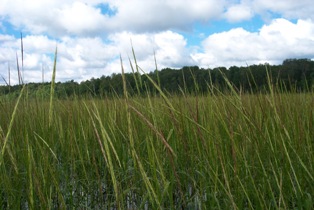
Wild rice is an annual plant that grows from seed each year. It begins to grow in lakes and streams after ice out in the spring. The plant typically grows best in shallow water depths (1-3 feet) in areas containing soft, organic bottoms.
Wild rice grows to the water surface usually by mid-June. During this time, wild rice plants lay flat on the water surface and can form vast leafy mats. During this floating-leaf stage (please see photo), wild rice is extremely susceptible to water level fluctuations. Plants can be uprooted and washed away due to increased water levels.
During July, wild rice will grow vertically (please see photo) and can eventually stand up to 6-8 feet out of the water. Each rice plant is unisexual, containing male spikelets below the female spikelets which are located at the end of the stalk. Cross pollination occurs naturally in rice beds usually in late July. Rice kernels begin to fill with a milky substance in late July to early August. These kernels harden to become the seed (or grain) of the plant.
Ripe wild rice seed will eventually fall into the water if not harvested. Seeds sink and settle into the sediment at the bottom of the lake or river. With favorable conditions, seeds will grow into wild rice plants beginning the next spring. However, wild rice seed also has the ability to remain dormant until favorable conditions are encountered. This dormancy can last for years if the seed remains in the water.
Wild rice is also susceptible to competing vegetation such as pickerel weed, water shield, and water lilies. Some floating-leaf species and emergent species begin their growth cycle in the spring before wild rice. These species can impede the growth of wild rice and eventually take over a water body.
Wild rice is ripe when the seeds are formed and ready to fall off. It is during this time that harvest can occur. Different lakes/rivers, different areas of the same lake/river, and even different seeds on the same plant ripen at different times. Due to this varied ripening, the same wild rice bed can be harvested several times in the same year. Depending on conditions, wild rice is typically not ripe and ready for harvest until late August or early September in northeastern Minnesota.


